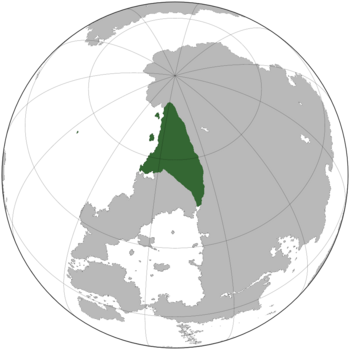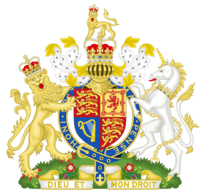Greater Niagara
This article is incomplete because it is pending further input from participants, or it is a work-in-progress by one author. Please comment on this article's talk page to share your input, comments and questions. Note: To contribute to this article, you may need to seek help from the author(s) of this page. |
Kingdom of Greater Niagara Større Niagara | |
|---|---|
| Motto: Pro Rex et Patria! | |
| Anthem: Rule, Niagara! | |
 | |
| Capital | Victoria |
| Largest City | Mikkel's Port |
| Official languages | Niagaran, Fluvan |
| Recognised national languages | Niagaran, Fluvan |
| Recognised regional languages | Niagaran |
| Ethnic groups (2018) |
|
| Religion (2018) |
|
| Demonym(s) | Niagaran |
| Government | Unitary parliamentary constitutional monarchy |
• Monarch | King Matthew IV |
| Sir Benjamin Mayhew | |
• Chief Justice of the Supreme Court | Lord Richard Kristoffersen, Earl of Aslaw |
| Legislature | Parliament of Greater Niagara |
| House of Lords | |
| House of Commons | |
| Establishment circa. 900 AD | |
• Beginning of the Niagaran Colonial Empire | circa 1500 AD |
• Beginning of Niagaran Civil War | May 23, 2019 |
| Area | |
• Total | 5,770,343 km2 (2,227,942 sq mi) (3rd) |
• Water (%) | 8% |
| Population | |
• 2022 estimate | 220,000,000 ([[List of countries and dependencies by population|4th]]) |
• 2020 census | 221,890,000 |
| GDP (nominal) | 2020 estimate |
• Total | £4.048 Trillion GNP ($3.2 Trillion USD) (5th) |
• Per capita | £18,399.99 GNP ($14,545.45 USD) (2020) (10th) |
| Gini (2018) | 60.9 very high ((5th)) |
| HDI (2019) | 0.78 high (6th) |
| Currency | Niagaran Pound Sterling (£) (GNP) |
| Time zone | VMT (?) |
| Date format | mm/dd/yyyy |
| Driving side | right side |
| Calling code | +5 |
| ISO 3166 code | GN, GNA |
| Internet TLD | .gn |
The Kingdom of Greater Niagara, simply Greater Niagara or Niagara, is a sovereign country in northern Abos, composing of the mainland, and other crown dependencies and overseas territories. With a surface area of [number], it is the second largest country in Abos and one of the larger countries in the world. Climates vary from temperate southern coasts, to the harsh winter landscape of the Kjolen mountains.
Niagara's population of over 220 million people has traditionally lived in a developed and urbanized society, but since the beginning of the Niagaran Civil War, the quality of life has dropped substantially. Victoria is the nation's capital, while the five largest cities are Mikkel's Port, Victoria, Arendal, Marksburgh, and Brevik. Niagara's abundant natural resources, and well developed industry (especially the military-industrial complex and oil-extraction industry) are vital to Niagara's economy, which generates income from resource extraction, services, mining exports, manufacturing, and military export.
Niagara has a developed middle-income economy; it has the worlds fifth-largest economy, sixth-highest per capita income, and the XX-highest Human Development Index score. Greater Niagara is a regional power and has the worlds XX-highest military expenditure. Niagara ranks fairly well in quality of life, health, education, and very well in economic freedom. However, it's political freedoms, and safety have been rapidly declining since the start of the Niagaran Civil War. It is a member of multiple international organizations, including the X, Y, and Z.
Etymology
History
Early History
Kingdom of Niagara
Expansion of the Empire
Act of Union to the 20th Century
Pre-war years and the First Great War
Niagaran Senatorial Republic and the Second Great War
Restoration of Democracy and Decolonization
Third Great War to the end of the 20th Century
21st Century
Niagaran Civil War
Geography
Climate
Government and Politics
Greater Niagara is a federal state under a constitutional monarchy. King Matthew IV is the monarch and head of state of Niagara, as well as King of Perlsienne. The monarch has "the right to be consulted, the right to encourage, and the right to warn". The Constitution of Greater Niagara is uncodified and consists mostly of a collection of disparate written sources, including statutes, judge-made case law and international treaties, together with constitutional conventions. The Niagaran Parliament can carry out constitutional reform by passing acts of parliament, and thus has the political power to change or abolish almost any written or unwritten element of the constitution. No sitting parliament can pass laws that future parliaments cannot change.
Greater Niagara is a parliamentary democracy and a constitutional monarchy. The Parliament of Greater Niagara is sovereign. It is made up of the House of Commons, the House of Lords and the Crown. The main business of parliament takes place in the two houses, but royal assent is required for a bill to become an act of parliament (law).
For general elections (elections to the House of Commons), Niagara is divided into 680 constituencies, each of which is represented by a member of Parliament (MP). MPs hold office for up to five years and are always up for re-election in general elections. The Conservative Party, Social-Democratic Party and Haltorian National Party are, respectively, the current first, second and third largest parties (by number of MPs) in the House of Commons.
The prime minister is the head of government in Greater Niagara. Nearly all prime ministers have served as First Lord of the Treasury and all prime ministers have continuously served as First Lord of the Treasury since 1905, and Minister for the Civil Service since 1968. In modern times, the prime minister is, by constitutional convention, an MP. The prime minister is appointed by the monarch and their appointment is governed by constitutional conventions. However, they are normally the leader of the political party with the most seats in the House of Commons and hold office by virtue of their ability to command the confidence of the House of Commons.
The prime minister not only has statutory functions (alongside other ministers), but is the monarch's principal adviser and it is for them to advise the monarch on the exercise of the royal prerogative in relation to government. In particular, the prime minister recommends the appointment of ministers and chairs the Cabinet.
Provincial Governments
Overseas Territories
Law and criminal justice
Foreign Relations
Military
For the main article, see Niagaran Armed Forces. The monarch is the ceremonial Commander-in-Chief of the Armed Forces, but delegates authority of running the miltiary to the Ministry of Defence. The Ministry of Defence administers the Army, Navy, Marine Corps, and Air Force. Niagara spends £265 billion on defence per year, or 6% of the GDP, and XX% of the global defence budget.
In 2022, all 4 branches of the Niagaran Armed Forces reported 1.55 million personnel on duty. The Reserves and Territorial Army brought the total to 1.84 million. The Ministry of Defence also employees 400,000 civillians, not including contractors. Military service in Greater Niagara was voluntary until 2019, when nationwide conscription began to be enforced, for the first time since the Third Great War.
Since 2019, the Niagaran Armed forces have been engaged in the Niagaran Civil War, which has led to the deaths of an estimated 300,000 personnel on both sides, and 100,000 civillians.


